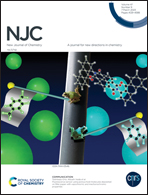Assessing the role of substituents in ferrocene acylphosphines and their impact on gold-catalysed reactions†
Abstract
Substituents can be used to efficiently modify the coordination and catalytic behaviour of phosphine ligands. In this article, we analyse how substituents affect the properties of ferrocene acylphosphines FcC(O)PR2 (1a–d), where PR2 is PPh2 (1a), PCy2 (1b), PAd2 (1c) and PCg (1d; Fc = ferrocenyl, Cy = cyclohexyl, Ad = 1-adamantyl, and PCg = 1,3,5,7-tetramethyl-2,4,6-trioxa-8-phosphaadamantane-8-yl). The 31P–77Se scalar coupling constants (1JPSe), determined for the corresponding phosphine selenides FcC(O)P(Se)R2 (2a–d), suggest that the basicity of the phosphine groups increases with the donor ability of the substituents R, as expected. Au(I) complexes [AuCl(1-κP)] (3a–d), obtained by replacing the dimethylsulfide ligand in [AuCl(SMe2)] with acylphosphines 1a–d, were tested in Au-catalysed alkyne hydration and intramolecular cyclisation of N-propargyl benzamide to yield 5-methylene-2-phenyl-4,5-dihydrooxazole. The collected results indicate that the highest reaction yields were generally obtained using catalysts derived from acylphosphines bearing the electron-donating aliphatic substituents 1b and 1c. From a wider perspective, the carbonyl moiety in the acylphosphines FcC(O)PR2 appears to lower steric crowding around the phosphorus atom (especially for compounds with bulky R substituents) and counterbalances the electron-donating effect of the ferrocenyl moiety.



 Please wait while we load your content...
Please wait while we load your content...